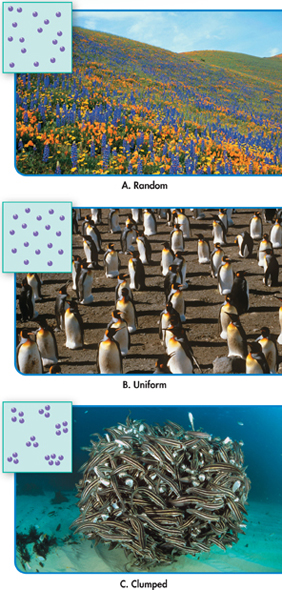Geographic Range The area inhabited by a population is called its geographic range. A population's range can vary enormously in size, depending on the species. A bacterial population in a rotting pumpkin, for example, may have a range smaller than a cubic meter. The population of cod in the western Atlantic, on the other hand, covers a range that stretches from Greenland down to North Carolina. The natural range of one hydrilla population includes parts of southern India and Sri Lanka. The native range of another hydrilla population was in Korea. But humans have carried hydrilla to so many places that its range now includes every continent except Antarctica, and it is found in many places in the United States.
Density and Distribution Population density refers to the number of individuals per unit area. Populations of different species often have very different densities, even in the same environment. For example, a population of ducks in a pond may have a low density, while fish in the same pond community may have a higher density. Distribution refers to how individuals in a population are spaced out across the range of the population—randomly, uniformly, or mostly concentrated in clumps, as shown in Figure 5–2.
Growth Rate A population's growth rate determines whether the size of the population increases, decreases, or stays the same. Hydrilla populations in their native habitats tend to stay more or less the same size over time. These populations have a growth rate of around zero. In other words, they neither increase nor decrease in size. The hydrilla population in Florida, by contrast, has a high growth rate—which means that it increases in size. Populations can also decrease in size, as cod populations have been doing. The cod population has a negative growth rate.
Age Structure To fully understand a plant or animal population, researchers need to know more than just the number of individuals it contains. They also need to know the population's age structure—the number of males and females of each age a population contains. Why? Because most plants and animals cannot reproduce until they reach a certain age. Also, among animals, only females can produce offspring.

FIGURE 5–2 Patterns of Distribution The dots in the inset illustrations represent individual members of a population. A. Purple lupines grow randomly in a field of wildflowers. B. King penguin populations show uniform spacing between individuals. C. Striped catfish form tight clumps.
dTable of Contents
- Formulas and Equations
- Applying Formulas and Equations
- Mean, Median, and Mode
- Estimation
- Using Measurements in Calculations
- Effects of Measurement Errors
- Accuracy
- Precision
- Comparing Accuracy and Precision
- Significant Figures
- Calculating With Significant Figures
- Scientific Notation
- Calculating With Scientific Notation
- Dimensional Analysis
- Applying Dimensional Analysis




